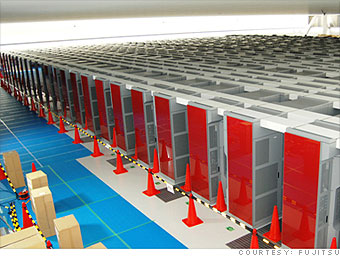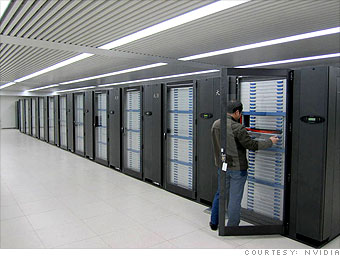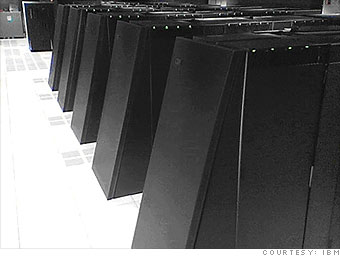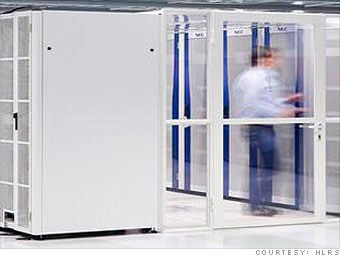The biannual Top 500 list, revised each June and November, shows that the fastest supercomputers are getting even faster.
No. 1: K Computer
The positions haven't shifted, but there were plenty of changes atop the list released Monday of the world's 500 fastest supercomputers.

K Computer, which became the world's fastest supercomputer by a factor of three five months ago, has been upgraded and is now four times speedier than the next-fastest. It is more powerful than the next seven supercomputers combined.
The supercomputer is capable of 10.51 Petaflops. That means it can do 10.51 quadrillion -- that's a million billion -- calculations per second. Hence the supercomputer's name: The letter "K" is short for the Japanese word "kei," which symbolizes 10 quadrillion.
For comparison's sake, the fastest commercially available Intel processor (the Core i7) is capable of about 109 gigaflops, or about 109 billion calculations per second. That means K Computer is more than 96,000 times faster than your PC.
The K Computer is a truly massive supercomputer: it comprises 864 computer racks. Still, it remains surprisingly energy efficient -- one of the most efficient on the list.
K Computer is used at the Riken Institute for Physical and Chemical Research in Kobe, Japan. The Riken Institute shares its computing power for researchers' projects around the world.
The Top 500 list is revised each June and November by researchers at the National Energy Research Scientific Computing Center, the University of Tennessee in Knoxville and the University of Mannheim in Germany. In the latest edition, unveiled Monday, the top 10 fastest supercomputers were unchanged since the last list came out in June. That's the first time that's happened since the list began in 1993.
No. 2: Tianhe-1A
Just a year ago, the Tianhe-1A was the fastest supercomputer on the planet. The fact that the K Computer is now four times faster than the Tianhe-1A shows just how rapidly things change in this space.

Located at the National Supercomputer Center in Tianjin, China, the Tianhe-1A is capable of achieving speeds of 2.57 quadrillion calculations per second.
It uses just 14,336 central processing units. That's because, unlike the K Computer -- which has more than 88,000 CPUs -- the Tianhe-1A has several thousand Nvidia graphics processors to accelerate computation. That saves a lot of floor space.
Like the K Computer, the Tianhe-1A is open for researchers to use for large-scale scientific computations. It is currently being used for drug discovery, hurricane and tsunami modeling, cancer research, car design, and studying the formation of galaxies.
The Chinese are coming on strong in supercomputing, with 75 systems on the Top 500 list -- second only to the United States.
No. 3: Jaguar
Once the fastest in the world at 1.75 quadrillion calculations per second, the U.S. Department of Energy's Jaguar supercomputer is now stuck in third place. But not for long.

The computer is in the process of getting an enormous upgrade. When several hundred AMD 12-core CPUs and 18,000 Nvidia graphics processors are installed, the DOE says Jaguar will be capable of 20 quadrillion calculations per second, which would make it twice as fast as the No. 1 K Computer. When the upgrade is finished early next year, the supercomputer will be appropriately renamed "Titan."
Built by Cray, Jaguar is located in the DOE's Oak Ridge National Laboratory in Tennessee. It is used for research on climate change, alternative fuel technologies and atomic energy, among other projects. It's an open system, so approved private companies and academics are also allowed to use the machine.
No. 138: Blue Gene Watson
The oldest supercomputer on the list just fell out of the top 100 for the first time.

When it debuted in July 2005, IBM's Blue Gene Watson was the second-fastest supercomputer in the world. It now ranks 138th-- still a remarkable achievement for a six-year old machine. The supercomputer is capable of 91.3 teraflops, or 91.3 trillion calculations per second.
Headquartered at the company's Thomas J. Watson Research Center in Yorktown, N.Y., Blue Gene Watson is primarily used to study physics, semiconductors and systems technologies that can be used to develop new IBM hardware, software and services. About 10% of the computer is devoted to external projects for other scientific researchers.
IBM, by far the largest supercomputer maker in the world, planned to run Watson -- its Jeopardy!playing computer -- on a Blue Gene supercomputer. Instead, IBM opted to run it on a commercially available Power 7 server, in order to demonstrate that businesses could one day buy a "Watson" for themselves.
No. 500: Baku
The 500th fastest supercomputer is Baku, a research machine located in Stuttgart, Germany.

Clocking in at 60 trillion calculations per second, it was in position No. 305 just six months ago. When it was built just two and a half years ago, it was the 77th fastest. That's how fast these machines become outdated.
The supercomputer, built by Cray, is one of just five systems in the Top 500 to run Windows. The vast majority of systems run the open-source Linux operating system, but a small handful feature other OS's, including Microsoft's lesser-known high-performance computing version of Windows, called Windows HPC 2008.
http://money.cnn.com




0 comments:
Post a Comment